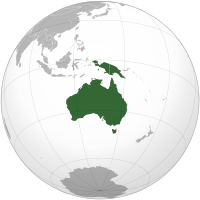 | |
| Area | 8,600,000 km2 (3,300,000 sq mi) (7th) |
|---|---|
| Population | 39,357,469[note 1] (6th) |
| Population density | 4.2/km2 (11/sq mi) |
| GDP (PPP) | 1.5 trillion |
| Demonym | Australian/Papuan |
| Countries | |
| Dependencies | |
| Languages | English, Indonesian, Tok Pisin, Hiri Motu, 269 indigenous Papuan and Austronesian languages, and about 70 Indigenous Australian languages |
| Time zones | UTC+8, UTC+9:30, UTC+10 |
| Internet TLD | .au, .id, and .pg |
| Largest cities | |
The continent of Australia, sometimes known in technical contexts by the names Sahul (/səˈhuːl/), Australia-New Guinea, Australinea, or Meganesia to distinguish it from the country of Australia,[1][2][3] is located within the Southern and Eastern hemispheres.[4] The continent includes mainland Australia, Tasmania, the island of New Guinea (Papua New Guinea and Western New Guinea), the Aru Islands, the Ashmore and Cartier Islands, most of the Coral Sea Islands, and some other nearby islands. Situated in the geographical region of Oceania, Australia is the smallest of the seven traditional continents.
The continent includes a continental shelf overlain by shallow seas which divide it into several landmasses—the Arafura Sea and Torres Strait between mainland Australia and New Guinea, and Bass Strait between mainland Australia and Tasmania. When sea levels were lower during the Pleistocene ice age, including the Last Glacial Maximum about 18,000 BC, they were connected by dry land into the combined landmass of Sahul. The name "Sahul" derives from the Sahul Shelf, which is a part of the continental shelf of the Australian continent. During the past 18,000 to 10,000 years, rising sea levels overflowed the lowlands and separated the continent into today's low-lying arid to semi-arid mainland and the two mountainous islands of New Guinea and Tasmania. With a total land area of 8.56 million square kilometres (3,310,000 sq mi), the Australian continent is the smallest, lowest, flattest, and second-driest continent (after Antarctica) on Earth.[5] As the country of Australia is mostly on a single landmass, and comprises most of the continent, it is sometimes informally referred to as an island continent, surrounded by oceans.[6]
Papua New Guinea, a country within the continent, is one of the most culturally and linguistically diverse countries in the world.[7] It is also one of the most rural, as only 18 percent of its people live in urban centres.[8] West Papua, a region in Indonesia, is home to an estimated 44 uncontacted tribal groups.[9] Australia, the largest landmass in the continent, is highly urbanised,[10] and has the world's 14th-largest economy with the second-highest human development index globally.[11][12] Australia also has the world's 9th largest immigrant population.[13][14]
Cite error: There are <ref group=note> tags on this page, but the references will not show without a {{reflist|group=note}} template (see the help page).
- ^ Heinsohn, Tom (October 2003). "Animal translocation: long-term human influences on the vertebrate zoogeography of Australasia (natural dispersal versus ethnophoresy)". Australian Zoologist. 32 (3): 351–376. doi:10.7882/AZ.2002.014. ISSN 0067-2238.
- ^ O'Connell, J. F; Allen, J (1 June 2004). "Dating the colonization of Sahul (Pleistocene Australia–New Guinea): a review of recent research". Journal of Archaeological Science. 31 (6): 835–853. Bibcode:2004JArSc..31..835O. doi:10.1016/j.jas.2003.11.005. ISSN 0305-4403.
- ^ Rasmussen, Claus; Thomas, Jennifer C.; Engel, Michael S. (December 2017). "A New Genus of Eastern Hemisphere Stingless Bees (Hymenoptera: Apidae), with a Key to the Supraspecific Groups of Indomalayan and Australasian Meliponini". American Museum Novitates (3888): 1–33. doi:10.1206/3888.1. ISSN 0003-0082.
- ^ New, T.R. (2002). "Neuroptera of Wallacea: a transitional fauna between major geographical regions" (PDF). Acta Zoologica Academiae Scientiarum Hungaricae. 48 (2): 217–27.
- ^ Agency, Digital Transformation. "The Australian continent". info.australia.gov.au. Archived from the original on 1 May 2022. Retrieved 1 November 2021.
- ^ Löffler, Ernst; A.J. Rose, Anneliese Löffler & Denis Warner (1983). Australia:Portrait of a Continent. Richmond, Victoria: Hutchinson Group. p. 17. ISBN 978-0-09-130460-7.
- ^ Seetharaman, G. (13 August 2017). "Seven decades after Independence, many small languages in India face extinction threat". The Economic Times.
- ^ "World Bank data on urbanisation". World Development Indicators. World Bank. 2005. Archived from the original on 3 February 2009. Retrieved 15 July 2005.
- ^ "BBC: First contact with isolated tribes?". Survival International. Retrieved 24 July 2015.
- ^ "Geographic Distribution of the Population". 24 May 2012. Retrieved 1 December 2012.
- ^ Data refer mostly to the year 2014. World Economic Outlook Database-April 2015, International Monetary Fund. Accessed on 25 April 2015.
- ^ "Australia: World Audit Democracy Profile". WorldAudit.org. Archived from the original on 13 December 2007. Retrieved 5 January 2008.
- ^ Statistics, c=AU; o=Commonwealth of Australia; ou=Australian Bureau of (19 May 2023). "Main Features – Cultural Diversity Article". www.abs.gov.au.
{{cite web}}: CS1 maint: multiple names: authors list (link) - ^ United Nations, Department of Economic and Social Affairs, Population Division, (2019). 'International Migration' in International migrant stock 2019. Accessed from International migrant stock 2015: maps on 24 May 2017.